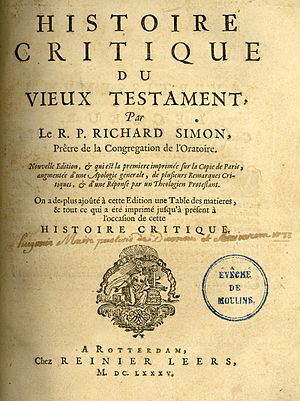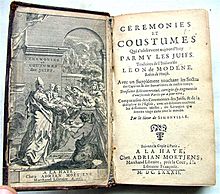Richard Simon (priest) facts for kids
Richard Simon was a French priest and a member of the Oratorians. He was an important Bible scholar, expert on Eastern cultures, and often got into arguments about his ideas.
Contents
Early Life and Studies
Richard Simon was born in Dieppe on May 13, 1638. He went to school at the Oratorian college in his hometown. He received financial help that allowed him to study theology (the study of religion) in Paris. There, he became very interested in Hebrew and other languages from the Middle East.
In 1662, he joined the Oratorians as a new member. After his training period, he was sent to teach philosophy at the College of Juilly. However, he was soon called back to Paris. His new job was to help create a list of all the Eastern books in the Oratory's library.
Troubles as an Oratorian
Simon became a priest in 1670. He then taught the art of speaking and writing well at Juilly until 1673. One of his students was the famous philosopher, Count Henri de Boulainvilliers.
Simon was influenced by the ideas of other thinkers like Isaac La Peyrère and Baruch Spinoza. Simon's way of studying the Bible later led some people to call him a "Father of the higher criticism". This means he was one of the first to study the Bible by looking at its history and how it was written.
Simon caused problems when he got involved in a legal fight. A friend, François Verjus, was an Oratorian who was working against the Benedictine monks of Fécamp Abbey. Simon wrote a strong paper to support his friend. The monks complained to the head of the Oratory. Simon was also accused of having ideas similar to the Jesuits, another religious group. This was because his friend's brother was a well-known Jesuit.
His Book Was Stopped
Simon wrote a very important book called Histoire critique du Vieux Testament. This means "Critical History of the Old Testament." When the book was being printed, it was approved by the University of Paris. The head of the Oratory also gave his permission. Simon hoped to dedicate the book to King Louis XIV of France.
However, Simon wrote very freely in his book. He even said that Moses might not have written all the parts of the Bible that people thought he did. This idea got a lot of attention. A powerful church leader named Jacques-Benigne Bossuet was upset. He worked with others to stop the book. A special order from the Royal Council was made. After many secret plans, the police seized all 1,300 copies of the book and destroyed them.
Later Life
Because of the trouble with his book, the Oratory group removed Simon in 1678. In 1679, he moved to a small church in Bolleville, Seine-Maritime. Later, he returned to Dieppe. Sadly, many of his books were lost when the city was attacked by ships in 1694. He died in Dieppe on April 11, 1712, when he was 74 years old.
His Writings
Much of what Simon wrote about the Bible was not completely new. Other scholars had already explored similar ideas. However, Simon's approach helped to continue the tradition of studying the Bible in a critical way.
Old Testament Studies
His famous book, Histoire critique du Vieux Testament (1678), had three parts. The first part looked at the original Hebrew text of the Bible and how it had changed over time. It also discussed who wrote the books of Moses and other parts of the Bible. Simon believed that in early Jewish history, there were people who recorded events. Their writings were kept in public records.
The second part of the book described the main translations of the Old Testament, both old and new. The third part talked about people who had written comments and explanations about the Bible.
The book had a difficult start. It was finally printed in 1685 in Rotterdam, Netherlands. This Dutch edition was actually the second version. It replaced the first French edition that had been destroyed. Simon had tried to make changes to the book to please Bossuet, but they could not agree.
A flawed version of the Histoire critique was also published in Amsterdam. This version was based on a handwritten copy that had been sent to England. From this copy, a Latin translation and an English translation were made. The Rotterdam edition included Simon's answers to people who had criticized his work.
New Testament Studies
In 1689, Simon published a similar book about the New Testament. It was called Histoire critique du texte du Nouveau Testament. This book had 33 chapters. In it, he talked about:
- Where the different books of the New Testament came from.
- How the Old Testament was quoted in the New Testament.
- The idea that the New Testament was inspired by God.
- The Greek language used in the New Testament.
- The Greek handwritten copies of the Bible known at that time.
After that, in 1690, he published Histoire critique des versions du Nouveau Testament. This book described the different translations of the New Testament, both old and new. It also discussed how difficult parts of the New Testament were translated in different versions.
In 1693, he published Histoire critique des principaux commentateurs du Nouveau Testament. This book looked at the main people who had written comments on the New Testament since the beginning of Christianity. In 1695, he added more thoughts in his Nouvelles Observations sur le texte et les versions du Nouveau Testament.
In 1702, Simon published his own French translation of the New Testament. It was mostly based on the Latin Bible used by the Church. However, his notes in the translation questioned some traditional readings that the Church supported. Again, Bossuet tried very hard to stop this work from being published.
Other Writings
Simon often used fake names in his writings and sometimes sounded angry when arguing.
He had early disagreements with a religious group called the Port-Royalists. Simon criticized a book they had written about the Eucharist (a Christian ceremony). His criticisms in 1669 made them very upset.
Simon's first major published work was Fides Ecclesiae orientalis (1671). This book aimed to show that the Greek Church's beliefs about the Eucharist were the same as the Roman Catholic Church's. In 1670, he also wrote a short paper to defend the Jewish people of Metz. They had been wrongly accused of killing a Christian child.
In 1675, Simon published a translation of a travel book by Girolamo Dandini about his trip to Lebanon. It was called Voyage au Mont Liban. Dandini was a good observer, and Simon wrote in the introduction that traveling was useful for religious scholars.
In 1676, Simon worked with some Huguenots (French Protestants) on a plan for a new Bible translation. He translated the first five books of the Bible, but the money for the project ran out.
See also
 In Spanish: Richard Simon para niños
In Spanish: Richard Simon para niños



